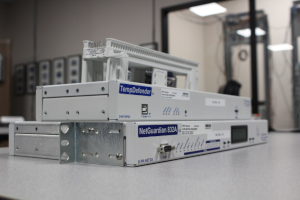Check out our White Paper Series!
A complete library of helpful advice and survival guides for every aspect of system monitoring and control.
1-800-693-0351
Have a specific question? Ask our team of expert engineers and get a specific answer!
Sign up for the next DPS Factory Training!

Whether you're new to our equipment or you've used it for years, DPS factory training is the best way to get more from your monitoring.
Reserve Your Seat TodayIf you operate a utility or manage critical infrastructure in the energy sector, you already understand the importance of NERC CIP compliance. These standards from the North American Electric Reliability Corporation (NERC) are designed to protect the bulk electric system (BES) from cyber threats. These requirements tend to grow more strict every year.
NERC CIP (Critical Infrastructure Protection) is not just a set of suggestions. It's a mandatory framework enforced across the United States, Canada, and parts of Mexico. Non-compliance can lead to hefty fines, operational disruptions, and even revoked operating privileges.
What makes NERC CIP especially challenging is its open-ended structure. The standards specify goals like protecting information in transit or controlling system access, but they rarely name specific technologies. This flexibility is intentional, but it often creates confusion:
DPS Telecom utility clients have been navigating these exact questions. That's why many are upgrading their infrastructure with NetGuardian G6 RTUs, which include capabilities that map (as directly as possible) to key NERC CIP requirements. The G6 platform provides a strong technical foundation to help you meet and document your cybersecurity obligations.

Many legacy RTUs and remote monitoring devices were developed before cybersecurity was a top concern. These devices were excellent at collecting data and triggering alarms, but they just weren't built with today's security standards in mind.
That's a problem when facing NERC CIP requirements like:
Most older doesn't perform these important modern functions:
If your infrastructure still includes these older devices, maintaining NERC CIP compliance might not be possible.
To build a network that's both easier to audit and more secure, your remote telemetry and control hardware should check off the following checkboxes:
Data should be protected both in transit and at rest. Devices should support modern encryption protocols like:
Your system should support multiple user accounts with assignable roles. Not everyone needs admin-level access. Fine-grained permissioning helps limit exposure and aligns with CIP-007-6 R5.
Support for RADIUS or similar authentication systems allows you to manage access centrally and revoke credentials easily. This can help you align with CIP-005-5 R2 and CIP-007-6 R5.
RTUs should log all critical activity, including login attempts, config changes, firmware updates, and communication failures. Logs should be timestamped and exported for centralized review, which relates to CIP-007-6 R4.
You should be able to disable unnecessary ports and services to reduce your attack surface. Compliance with CIP-007-6 R1 hinges on having only required services active.
You need the ability to apply security patches quickly (without replacing hardware). Devices should be field-upgradable and come from a vendor with responsive engineering support.
Whether updating configurations or exporting logs, your RTU should allow secure transfers using SFTP, HTTPS, or other encrypted channels. You'll find this type of requirement in CIP-011-1 R1.2.
Hardware is only part of the picture. Your vendor should offer:
DPS Telecom's NetGuardian G6 platform was engineered with all of the above criteria in mind. The G6 gives you a compliance-ready foundation with a long list of capabilities that support your regulatory strategy.
As I've described, the code is not explicit with particular technologies, so it is always open to interpretation. Still, I've written the following guidelines for you after reviewing the requirements documents and comparing that to our G6 capabilities.
At DPS Telecom, we don't just make RTUs. We partner with you to help you solve real compliance problems.
Because we own our entire design and manufacturing process, we can customize NetGuardian RTUs at the firmware, software, or hardware level to meet your specific requirements. This flexibility is key when regulations change or new security threats emerge.
With DPS, you get:
We follow the exact kind of "value stacking" that many business experts describe. We're not just selling boxes. We're creating irresistible offers by combining products, customization, and expert support to solve your full compliance puzzle.
Let's be clear: NERC CIP compliance is a shared effort. The responsibility to design, document, and enforce a compliant infrastructure always falls to the utility itself.
However, when you have the right technology partner, one that understands both compliance and field-ready reliability, that job gets a lot easier.
With NetGuardian G6 RTUs, you're not just collecting telemetry. You're building a system with:
That's how you move from uncertain compliance to confident readiness.
If you're evaluating your next steps toward NERC CIP readiness - or you're tired of the patchwork approach - it's time to see how NetGuardian G6 RTUs can help you build a secure, modern, and compliant monitoring infrastructure.
We'll listen to your specific goals and show you how G6 gear can be customized to meet them.
Contact DPS Telecom today at 1-800-622-3314 or email sales@dpstele.com
Let's make your compliance job easier.

Andrew Erickson
Andrew Erickson is an Application Engineer at DPS Telecom, a manufacturer of semi-custom remote alarm monitoring systems based in Fresno, California. Andrew brings more than 19 years of experience building site monitoring solutions, developing intuitive user interfaces and documentation, and opt...